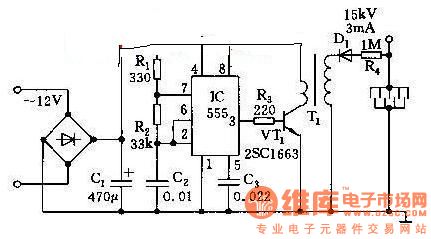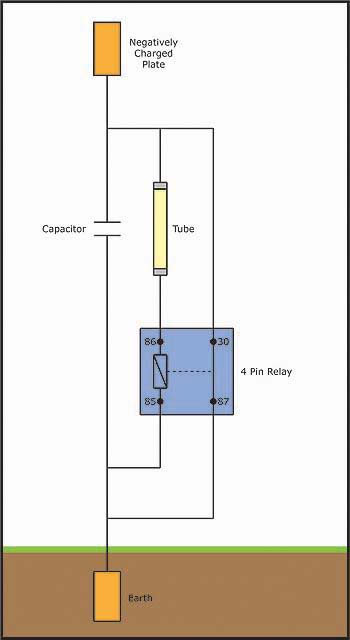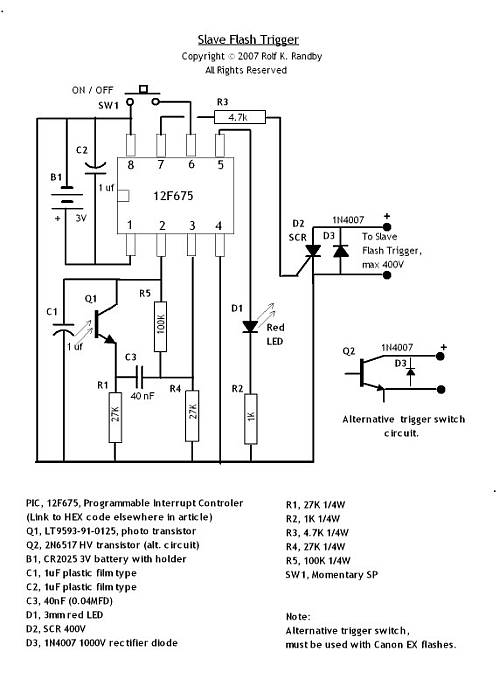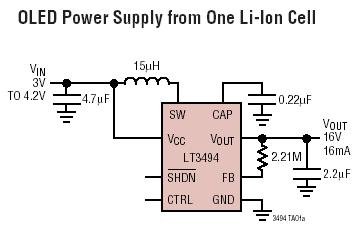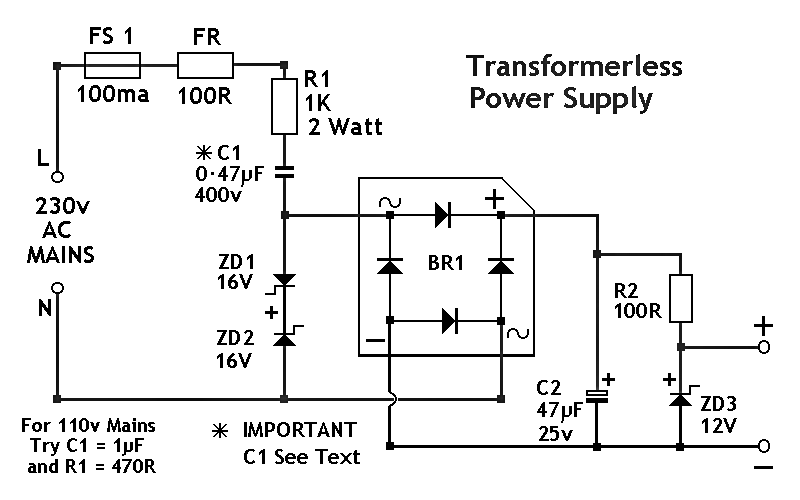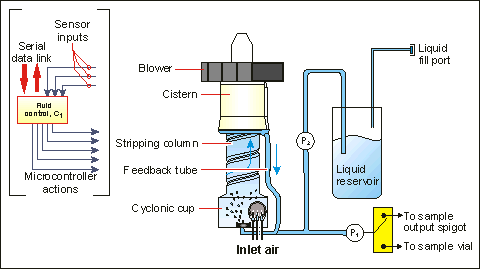
low voltage cutout for 12v sla
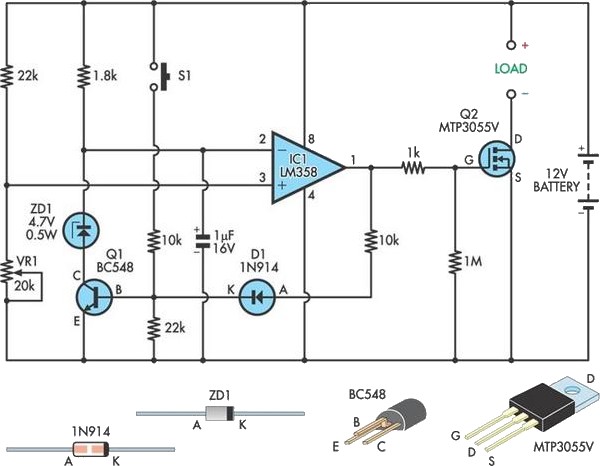
This circuit safeguards a sealed lead-acid (SLA) battery from over-discharge by disconnecting the load when the terminal voltage drops below a specified threshold. The operation involves deriving a sample of the battery voltage through a voltage divider composed of a 22kΩ resistor and a 20kΩ trimpot. This sampled voltage is fed into the non-inverting input (pin 3) of an operational amplifier (IC1), where it is compared to a reference voltage applied to the inverting input (pin 2). When the sampled voltage falls below the reference level, the output of IC1 (pin 1) transitions towards ground, turning off the MOSFET (Q2) and disconnecting the load from the battery. The reference voltage is generated using a 4.7V zener diode (ZD1), which is connected to ground through the collector-emitter path of a transistor (Q1) when it is in the 'on' state. Conversely, when the output of the op-amp goes low, Q1 turns off, allowing the non-inverting input to rise toward the full battery voltage. This action enhances the switching effect, latching the circuit in the "off" state until the battery is recharged and the reset switch (S1) is activated. The MOSFET selected for Q2 should be appropriate for the specific application. Additionally, the circuit can drive a relay by connecting the relay coil across the load terminals, with a diode placed across the relay coil to suppress back-EMF spikes.
This circuit provides an effective solution for preventing over-discharge of SLA batteries, which can lead to reduced battery life and performance. The voltage divider configuration ensures that the battery voltage is accurately monitored, allowing for precise control over the load disconnection process. The use of an operational amplifier enables a fast response to voltage changes, ensuring that the load is disconnected promptly when the battery voltage falls below the set threshold.
The choice of components, such as the specific values of the resistors in the voltage divider and the characteristics of the MOSFET, is critical for optimizing the performance of the circuit. The 22kΩ and 20kΩ resistors can be adjusted to fine-tune the voltage threshold at which the load is disconnected, accommodating different battery specifications and application requirements.
Furthermore, the inclusion of a zener diode for reference voltage stabilization is essential, as it provides a consistent reference point for the operational amplifier, enhancing the reliability of the circuit. The transistor (Q1) functions as a switch that further reinforces the latching mechanism of the circuit, ensuring that once the load is disconnected, it remains in that state until manually reset.
For applications that require higher current loads, the selection of the MOSFET (Q2) should be based on its current rating and R_DS(on) value, ensuring minimal energy loss during operation. If a relay is used instead of a MOSFET, careful consideration must be given to the relay's coil voltage and current ratings, and the diode across the coil must be rated to handle the back-EMF generated when the relay is de-energized.
Overall, this circuit design is a practical solution for battery management, ensuring the longevity and reliability of SLA batteries in various applications.This simple circuit protects an SLA battery from over-discharge by disconnecting the load when the terminal voltage drops below a preset level. In operation, a sample of the battery voltage is derived from the 22k © resistor and 20k © trimpot divider.
This is applied to the non-inverting input (pin 3) of IC1, where it is compared with a reference voltage on the inverting input (pin 2). When the sampled battery voltage falls below the reference voltage, IC1`s output (pin 1) swings towards ground, switching Mosfet Q2 off and disconnecting the load from the battery. The reference voltage is derived from a 4. 7V zener diode (ZD1), which is connected to ground via the collector-emitter circuit of Q1 (ie, when Q1 is on).
However, when the op amp`s output is driven low, Q1 is switched off, causing the non-inverting input to rise towards the full battery voltage. This greatly reinforces the switching action, latching the circuit in the "off" state until the battery is recharged and the reset switch (S1) pressed.
The Mosfet used for Q2 should be selected to suit the intended application. The circuit could also drive a relay simply by connecting the coil across the "load" terminals. As is usual practice, a diode should be connected across the relay coil to limit back-EMF spikes. 🔗 External reference
This circuit provides an effective solution for preventing over-discharge of SLA batteries, which can lead to reduced battery life and performance. The voltage divider configuration ensures that the battery voltage is accurately monitored, allowing for precise control over the load disconnection process. The use of an operational amplifier enables a fast response to voltage changes, ensuring that the load is disconnected promptly when the battery voltage falls below the set threshold.
The choice of components, such as the specific values of the resistors in the voltage divider and the characteristics of the MOSFET, is critical for optimizing the performance of the circuit. The 22kΩ and 20kΩ resistors can be adjusted to fine-tune the voltage threshold at which the load is disconnected, accommodating different battery specifications and application requirements.
Furthermore, the inclusion of a zener diode for reference voltage stabilization is essential, as it provides a consistent reference point for the operational amplifier, enhancing the reliability of the circuit. The transistor (Q1) functions as a switch that further reinforces the latching mechanism of the circuit, ensuring that once the load is disconnected, it remains in that state until manually reset.
For applications that require higher current loads, the selection of the MOSFET (Q2) should be based on its current rating and R_DS(on) value, ensuring minimal energy loss during operation. If a relay is used instead of a MOSFET, careful consideration must be given to the relay's coil voltage and current ratings, and the diode across the coil must be rated to handle the back-EMF generated when the relay is de-energized.
Overall, this circuit design is a practical solution for battery management, ensuring the longevity and reliability of SLA batteries in various applications.This simple circuit protects an SLA battery from over-discharge by disconnecting the load when the terminal voltage drops below a preset level. In operation, a sample of the battery voltage is derived from the 22k © resistor and 20k © trimpot divider.
This is applied to the non-inverting input (pin 3) of IC1, where it is compared with a reference voltage on the inverting input (pin 2). When the sampled battery voltage falls below the reference voltage, IC1`s output (pin 1) swings towards ground, switching Mosfet Q2 off and disconnecting the load from the battery. The reference voltage is derived from a 4. 7V zener diode (ZD1), which is connected to ground via the collector-emitter circuit of Q1 (ie, when Q1 is on).
However, when the op amp`s output is driven low, Q1 is switched off, causing the non-inverting input to rise towards the full battery voltage. This greatly reinforces the switching action, latching the circuit in the "off" state until the battery is recharged and the reset switch (S1) pressed.
The Mosfet used for Q2 should be selected to suit the intended application. The circuit could also drive a relay simply by connecting the coil across the "load" terminals. As is usual practice, a diode should be connected across the relay coil to limit back-EMF spikes. 🔗 External reference
